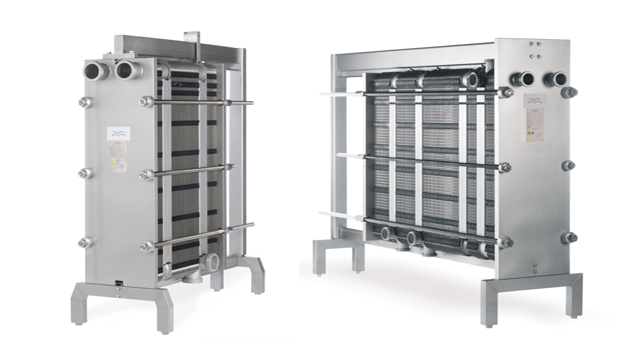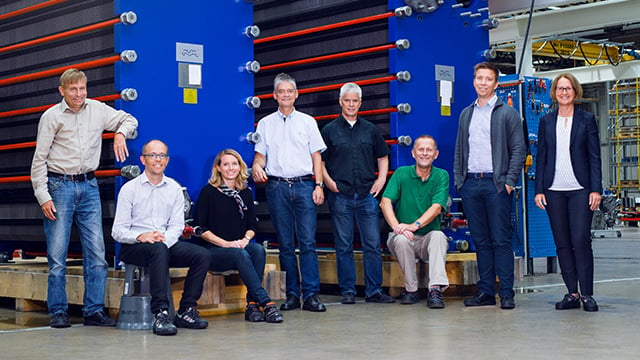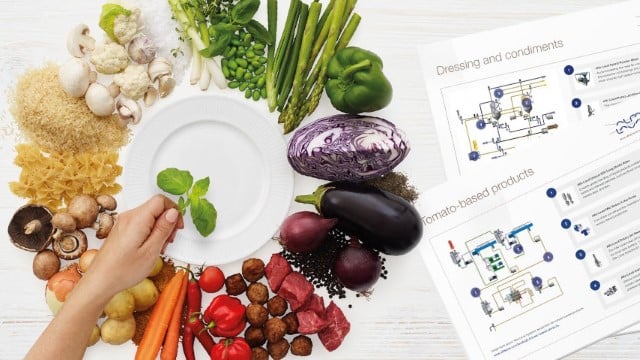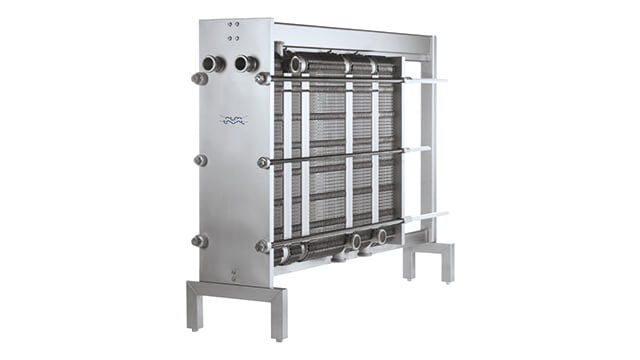FrontLine
Alfa Laval FrontLine is our premium range of plate heat exchangers for applications with the strictest demands regarding hygienic control as well as gentle product treatment, long operating time and superior cleanability. Suitable for applications with specific hygienic needs such as beverages, dairy and food, FrontLine is the superior choice for heat sensitive media. The flexible design makes for easy rebuild.
Designed for gentle, uniform heat transfer for sensitive hygienic products
- Superior hygienic performance from plates developed specifically for food and other hygienic applications (FCM compliant)
- Gentle, uniform treatment and reliable performance ensured by wide choice of heat exchanger plate materials and plate patterns
- Flexible configuration and easy to maintain for long service life
- Specific fouling-resistant design provides for long running times
- Range of plates makes FrontLine easily scalable to ensure consistent product quality
Plate types for different hygienic needs
FrontLine plate heat exchangers are available with three different types of plates, all of which are designed for sensitive, hygienic applications and uncompromising cleanliness.
- Clip plate – has a chevron plate pattern designed for hygienic conditions. The entry points, the distribution area, and the shape and depth of the pressed plate pattern allow for optimal performance.
- Clip plate Gemini double wall – consists of two plates pressed together. This prevents cross contamination between fluids in case of leakage through the plates.
- Clip plate WideStream – has a wider plate pattern with fewer contact points, which makes it ideal for products containing pulp or fibres.
FrontLine’s plate pattern and pressing depth are designed for gentle, uniform heat treatment of sensitive dairy, food and beverage products. Examples of applications in the food industry include:
- Pasteurization of yoghurt, ice cream and beer
- Pasteurization of fruit juice with fibres
- Heating and cooling of viscous products
Alfa Laval BaseLine heat exchangers is recommended for less demanding hygienic applications.
Interchangeable connection plate corners
Automatic model for easy use in pasteurization with high throughput
Alfa Laval’s FrontLine Automatic is an extended version that has a motor and a PLC based control system for automatic opening and closing of the plate heat exchanger. This is suitable for larger units in dairy pasteurization with high throughput where there is requirement for frequent inspection and cleaning.
How it works
Channels are formed between the plates and the corner ports are arranged so that the two media flow through alternate channels. The heat is transferred through the plate between the channels, where the counter-current flow helps attain the highest possible efficiency. The corrugation of the plates provides the passage between the plates, supports each plate against the adjacent one and enhances the turbulence, resulting in efficient heat transfer. Our thermal design engineers will help you design and select the model and configuration that is suitable for your application needs while delivering maximum thermal performance and minimizing pressure drop.
Alfa Laval hygienic liquid/liquid GPHE
Alfa Laval multi-section pasteurizer GPHE
Multi-section hygienic GPHE
Features
Adjustable feet
Bearing box
Connection plate roller
Elongated nuts
Fixed bolt head
Key hole bolt opening
Lock washer
Pressure plate roller
Tightening bolt cover
Part of a broad range of hygienic gasketed plate heat exchangers

Ten top tips - Hygienic Gasketed Plate Heat Exchangers
Here are some tips and service videos to show you how you can keep your hygienic gasketed plate heat exchangers in tip top condition.
Demand new standards
Introducing the world’s most modern Gasketed plate heat exchangers. Discover how our next-generation line of gasketed plate heat exchangers will bring you higher efficiency, better reliability and greater serviceability.

Food Logic
Alfa Laval's hygienic equipment combines high performance with gentle handling to preserve sensitive ingredients. Keeping up with the food industry trends and addressing four key challenges; supplying food products to consumers at a competitive price, getting the most from raw materials, reducing waste and emissions, and delivering safe and hygienic food products.


